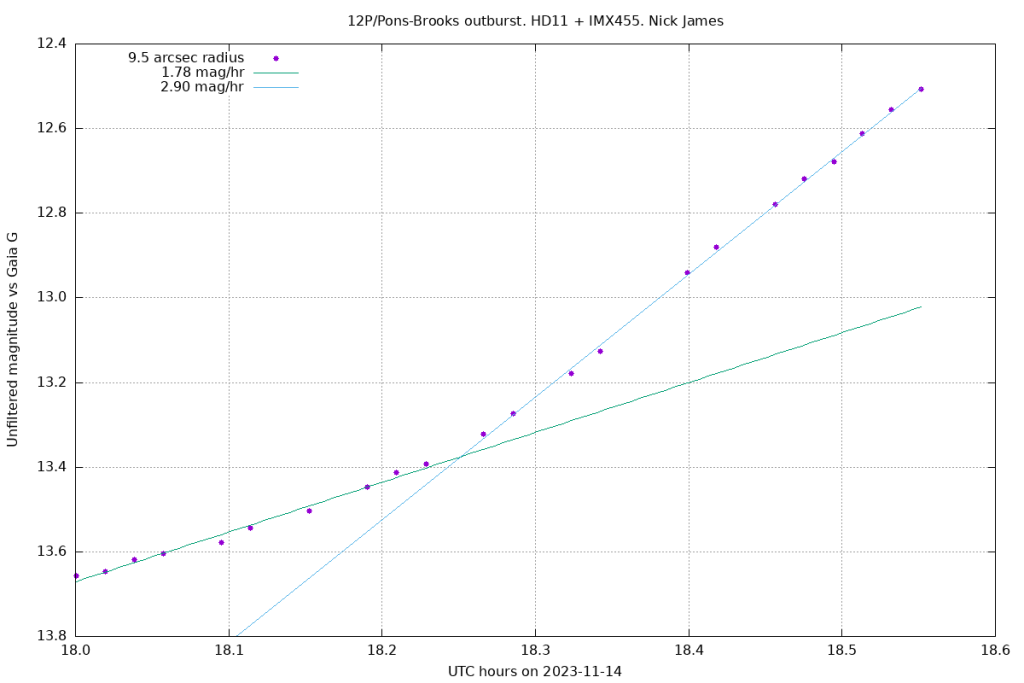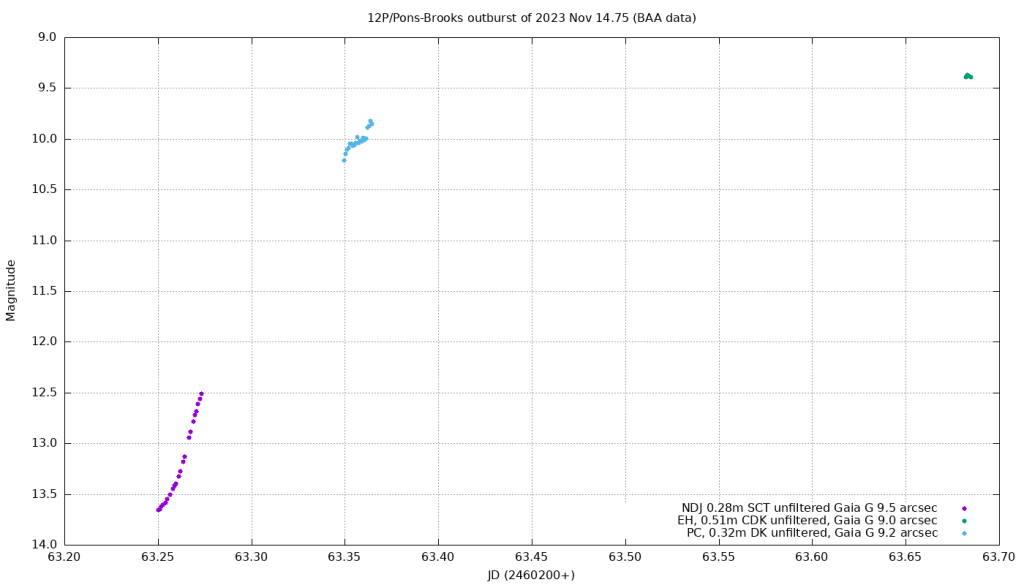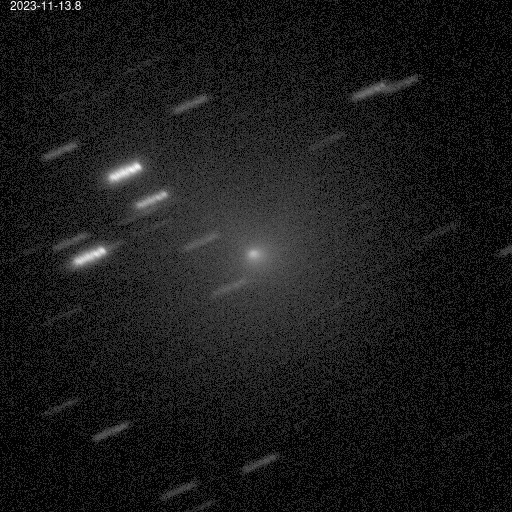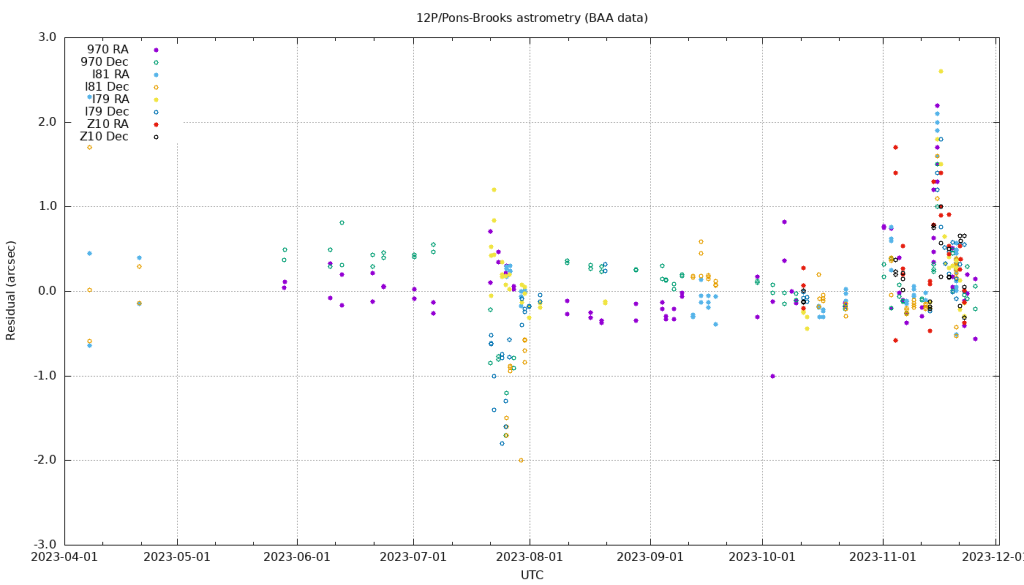2023 November 26
Comet 12P/Pons-Brooks outbursts continue
This is a preliminary report on the latest outburst and a comparison with previous outbursts. It is subject to updates.
The latest outburst of this very active comet occurred on the evening of 2023 November 14, just as it got dark in the UK, and we caught it on the rise. Perihelion, at q = 0.78 au, is not until 2024 April 21 so there is plenty of time for more outbursts over the next few months. This comet has a history of outbursts on previous apparitions, most occurring pre-perihelion, and so the ones that we are seeing now are not a surprise. It is likely that the discovery by Pons in 1812 and recovery by Brooks in 1883 took place when the comet was in outburst. Modern observing methods mean that we are gathering much more data now that was possible at the last return in 1954 and much of this comes from amateur observation.
We have received many observational reports from observers around the world. Images have been posted in the BAA gallery and observations submitted to the section have been archived here. This report covers astrometry and standardised photometry submitted to the section and uses data from the following observers:
Nick James, NDJ (970 & I79)
Denis Buczynski, DGB (I81)
Peter Carson, PC, (Z10)
Eliot Herman, EH
If anyone has images of the comet taken between Nov 14.5 and Nov 15.5 please contact the undersigned since these may be useful to fill in the gaps in the lightcurve below.
This was the fourth large outburst of this comet . There have also been a number of smaller amplitude outbursts of less than one magnitude. In each case it appears that the outburst is driven by a sudden release of a large volume of material (gas and dust) and its subsequent expansion into the vacuum of space surrounding the nucleus. Magnitudes in the following table are in an approximately 9 arcsec radius (36,000 km at the comet), unfiltered or V relative to Gaia G. Velocities are for expansion of the dust coma and are derived from measurements of the diameter using comphot.
| Outburst date | Reference | Peak | Ampl | Vel m/s |
r (au) | Notes |
| 2023 Jul 20.39 | JBAA 133/5 | 11.7 | 5.1 | 201 | 3.89 | |
| 2023 Oct 5.16 | BAA | 11.8 | 3.9 | 228 | 3.07 | |
| 2023 Oct 31.48 | List | 11.2 | 3.7 | 194 | 2.76 | Possibly double event, second outburst on Nov 1.40 |
| 2023 Nov 14.70 | List | 9.4 | 5.1 | 313 | 2.59 |
The latest outburst was a strong one and the comet brightened to a total magnitude of around 8.8. The magnitude of the bright, expanding, dust coma was around 9.4 and it was an easy visual object in a moderate telescope. The comet became bright enough that it could be imaged using a fixed camera and telephoto lens and complex structures were visible at longer focal lengths.
Photometry obtained using a 9.5 arcsec radius very shortly after the outburst commenced shows the comet brightening rapidly. Interestingly there is a change in slope of the brightening rate from 1.78 mag/hr to 2.90 mag/hr at around 18:15 UTC. This is very obvious from the lightcurve shown in figure 1. The reason for this change of slope is unclear. It could be that the outburst was actually two events, close in time or it could be that this is something to do with the properties of the dust in the coma. Prior to the outburst the magnitude in a 9.2 arcsec radius aperture was 14.5. The earliest observation during the outburst was a 18:00 UTC when the magnitude was around 13.7. At a rise rate of 1.8 mag/hr this implies the outburst occurred at around 17:30 UTC, i.e. 2023 Nov 14.73.

Figure 1 – Photometry obtained around 30 minutes after the outburst commenced.
A lightcurve showing the magnitude measured in a small aperture (approx 9 arcsec radius) shows the magnitude peaking at around 9.4 before fading over the subsequent days. The comet’s total magnitude (measured in an aperture which admits all of the light from the comet) was constant at around magnitude 8.8 but the magnitude in a small aperture drops as material expands outside of it. At the time of writing the magnitude in a 9 arcsec aperture seems to have stabilized at around 13.8. This is around 0.7 magnitudes above the pre-outburst level.

Figure 2 – Small aperture photometry shows the magnitude rising rapidly at Nov 14.75, continuing to rise but more slowly at Nov 14.85 and then levelling out.

Figure 3 – Small aperture photometry showing the brightness of the comet in an aperture corresponding to approx. 36,000 km at the comet.
Following the outburst the comet showed two concentric, spherical comae. The inner, bright, dust coma and an outer, fainter, gas coma. In colour images the two were very distinct with the dust coma white from reflected sunlight and the and the gas coma greenish from Swan band emission. Complex features were visible in the dust coma including a bright outflow to the NE, a curved flow to the east and a corresponding darker area to the north of this flow. These features are likely due to dust column density variations in our line of sight and they will have been caused by the complex dust flows in place shortly after the outburst. This is shown in the animation.

Figure 4 – Expansion of the inner (dust) and outer (gas) coma following the outburst. Images obtained using the Alnitak telescope (I79) in Spain as part of the BAA time allocation. This image is 4.5 arcmin square (approx 540,000 km at the comet), N up, E left.
The expansion rate of the dust coma in the days after this outburst was around 310 m/s. This was faster than the previous large outbursts as shown in figure 5. It does appear that this outburst was considerably more energetic than previous ones.

Figure 5 – Physical expansion rate of the bright dust coma obtained from coma diameter measurements made using comphot.
This latest outburst was large but it has had no detectable effect (so far) on the motion of the very massive nucleus of 12P. Figures 6 and 7 show astrometric residuals from various stations from Findorb using an orbit fit that uses positions obtained up to Nov 13. There is a large temporary displacement of the residuals around the time of major outbursts since the bright dust outflow biases the photo-centroid. In particular on Nov 15 and 16 there is a significant bias caused by the very bright dust cloud moving NE from the nucleus. As this dust cloud fades the astrometry is returning to normal. This comet has a very large and massive nucleus and so we do not expect these outbursts to have any significant effect.
Maik Meyer was responsible for demonstrating that this comet was seen in 1385 and 1487 and comments that the perihelion arrival adjustment required was just a few days despite it not being seen at four consecutive perihelia (1527, 1597, 1668 and 1740). This implies the effect of accumulated non-gravitational forces on this comet is very small and so we would not expect to see much effect this time around either.

Figure 6 – Astrometric residuals for 12P/Pons-Brooks from 2023 April to date. Note the large residuals following the July 20, October 31 and November 14 outbursts.

Figure 7 – Astrometric residuals for 12P/Pons-Brooks around the time of the two latest outbursts.
This is turning out to be a really fascinating comet to observe. Please try to observe it whenever you can. Please submit your images and observations to the section but also please submit astrometry and standardised photometry so that we can track its progress.
| The British Astronomical Association supports amateur astronomers around the UK and the rest of the world. Find out more about the BAA or join us. |
